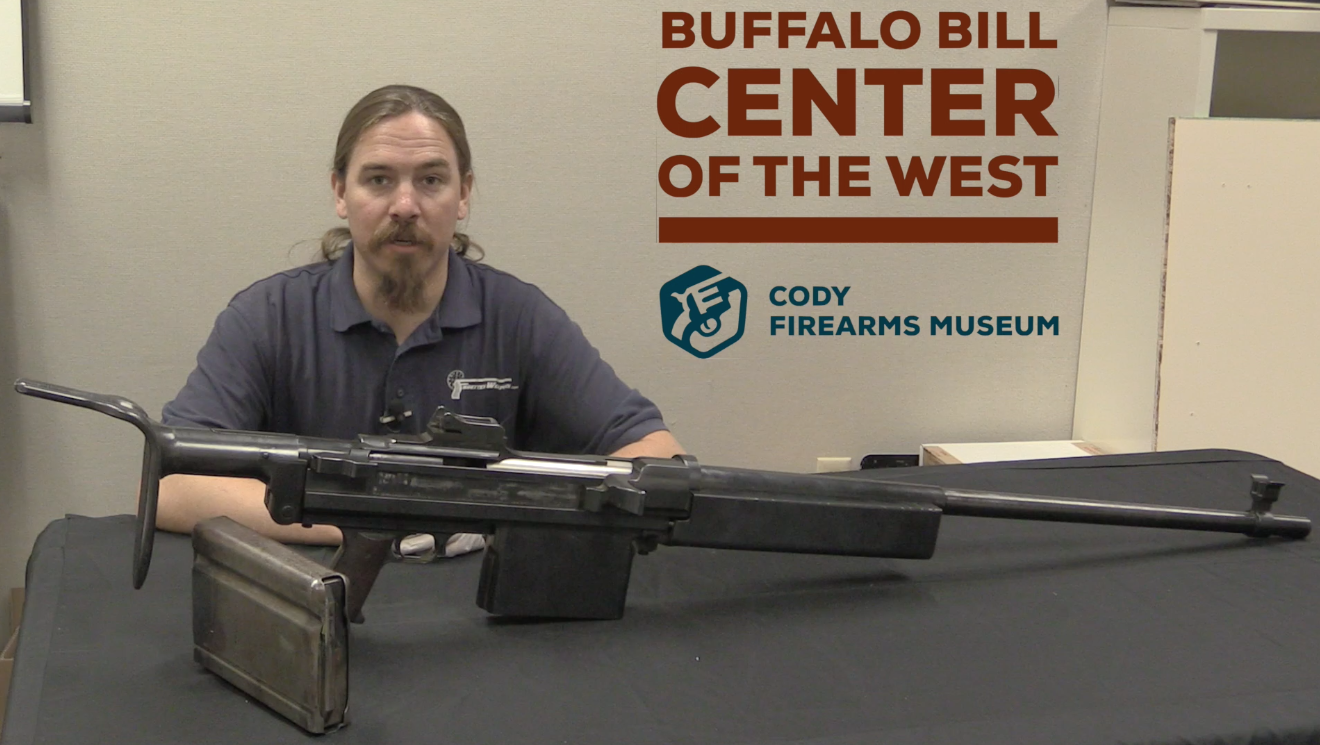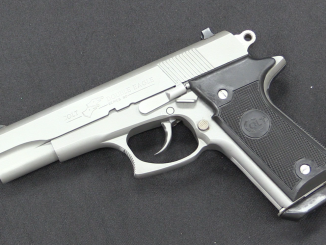James Merrill was a Baltimore inventor and businessman who patented an improvement to the Jenks pattern carbine in 1858. His idea was for an improved locking lever for the gun, which would also allow the use on paper or linen cartridges instead of loose ball and powder. He demonstrated the improvement at the Washington Navy Yard in 1858, and received a contract to convert 300 of the Navy Jenks carbines to his new system.
He did so, and had his guns almost immediately returned to him, as the springs in the lever latch were apparently too weak. He fixed this problem, but only submitted 240 carbines back to the Navy (the reason for the 60-gun loss is unknown). He received no further orders, but he did produce a new-manufacture carbine using the same patent which he sold to the Army during the Civil War.




This could make a nice reproduction in a revolver caliber or possibly something like 45/70.
Does center-fire conversion of that weapon exist? If it could be done how much alteration would be needed?
The improvements are great but why not advertise for mass production of new weapons and give customers the user manual to avoid the problems of abuse and incorrect powder loading?
Pornography.
I’d actually never heard of Porn hub, anyway I digress.
To be honest I’d consider it a perk. Actually I’ll just shut up.
Nice gun 🙂
@Pdb:
Pdb at MARCH 27, 2018 AT 9:40 AM:
“Actually I’ll just shut up. ”
Next post: MARCH 27, 2018 AT 9:46 AM
Taking in account above it looks that your declarations and actions lack convergence. Please try to avoid to such situations in future.
I simply refuse to try.
Having tried… He he, meh.
Look “Boris” beep you. Beeep, beeeeep, beep, beep? Beeeep, beep, beep head, beep. Beep, beep, beep… Beep. Telling me, beep, what I can say, beep. Beep, or what I should acquiesce too, beep.
Beep. And good evening.
Interesting site. This. As oppose Porn hub. Hum, hum, deedle dee, doodle dee, dum, da’da, day.
Imagine a “Hub” for, like… Forgotten weapons. Genius really.
Through all history of fire-arms there was tendency for increasing effective Rate-of-Fire and this weapon is not exception.
Quite.
I don’t understand: you agree with above statement of increasing effective Rate-of-Fire, disagree or declaring neutrality in this regard?
Agree! Huzzah!!
Puckle gun. For example.
Any thoughts on the charge of the light brigade? My great…grandads, Uncle… Or something took part,
apparently. He had an epic beard. Saw a photograph, once.
Biblical beard.
“charge of the light brigade”
As observer, it looks to be something of sacred thing for 19th century British citize… wait wrong… subjects of queen Victoria. It should be noted that it happened due to problems with orders, which were either not made clear enough or deformed by captain Nolan delivering them.
Despite regarding this even as important, it seems that history of survivors who returned to Great Britain was not happy nor splendid, see:
http://www.kiplingsociety.co.uk/poems_brigade.htm
Fair point.
Mind you, it left a few Russians opened mouthed at the time in awe.
Do Russians still long, for a daft sort of “glory” out of interest? Particularly after being so prudish in ridding the world of Nazi evil, is their something within them that wants a “silly charge” you can say, we are all friends here.
You know, not duty… Monotonous duty, amen, up the third international whatever; but are you eager to reach out and touch people- Possibly because of internal problems, or general boredom “are you a bit 3rd world really, shopping centre fires etc”. Or are you now trying to live out some epic poem, Völuspá.
We all know how they end, so I wish your land all the best.
The Chinese eat birds nests, what would Peter the great say.
“Chinese eat birds nests, what would Peter the great say.”
Soldiers’ bellies are not satisfied with empty promises and hopes.
Indeed.
“Do Russians still long, for a daft sort of “glory” out of interest? Particularly after being so prudish in ridding the world of Nazi evil, is their something within them that wants a “silly charge” you can say”
Probably every nation has such people. I am not sure if you have equivalent of «Военно-историческая фантастика» or War-historic fantasy, but it is popular in Russia, in most cases there are stories of modern men teleported in time (chronoported?), one of examples is Мы из будущего: http://www.imdb.com/title/tt1192431/
there exist many books of that genre, see: https://www.livelib.ru/pubseries/356031-voennoistoricheskaya-fantastika
although our times -> Great Patriotic War seems to be most exploited, there existed other variations as well: T-34 with crew from 1945 to Russo-Japanese War of 1905, USSR from 1941 into 21th century, RONA into 1917 (Russian Civil War) and even Darth Vader to 1941 where he made alliance with Stalin.
correction:
is: “(…)RONA(…)”
should be: “(…)ROA(…)”
One of cover of war-historic fantasy genre is discussed here:
http://enrique262.tumblr.com/post/150414240865/enrique262-theoldarmor-enrique262-of-all
as it was separated from its content, it looks like something is wrong here, but it is intentional, as it is alternate history.
Your very kind.
Quite similar to a modern D.I.Y Cigarette “roller” design; the filtered empty tube, type.
The rolled paper cartridge was at first a temporary item and even considered optional for all intents and purposes as the original role was powder dosage. Only after percussion priming did the concept of combustible paper cartridges come into play, and with it the question of whether the primer was included in the paper package or stuck on the exterior of the gun. For the muzzle loader and early breech loading percussion guns the primer was always stored separate from the powder before loading the guns (nobody wants a pratfall to set off the cartridge box). For the needle guns before metallic cases, great attention to detail was required to properly seat paper cartridges lest the firing pin fail to reach the primer (one was not supposed to shove the round into the chamber by means of slamming the bolt shut, since the cartridge paper might get ripped that way). Did I mess up?
Continuing from my reference on the original Jenks (the next paragraph on the same page, actually);
As stated, Merrill went on to deliver over 15,000 “Merrill” carbines to the Union Army. However, strictly speaking, the action was that of the Jenks, with Merrill’s only contribution being the conventional hammer and the spring-loaded breech-lever catch behind the rear sight. So if Mr. Jenks was still around at the time, he was probably owed at least some royalties on the use of what was still essentially his patented breech system.
Oh, and NB; John Adolphus Bernard Dahlgren, designer of the Dahlgren smoothbore naval gun, OIC of the Washington Navy Yard, founder and first chief of the Bureau of Naval Ordnance, and etc., was a U.S. Navy admiral, not an Army general;
https://en.wikipedia.org/wiki/John_A._Dahlgren
😉
cheers
eon
General Dahlgren! Do you mean Admiral Dahlgren?
Even though he was Commander at that time.
Would the annular ring in the bolt have held an obturating washer, maybe rubber or leather?
Is there any record of these guns ever being used. or even issued to warships in commission? 240 guns is such a minute number of guns for any for armed force, even in the late 1850’s, that we should wonder how on earth the deal happened. Buying 300, returning them all, accepting 240 fixed ones back, then doing nothing with them!?
If this gun was a trial/test buy by the USN then it must have failed, but no record of the trial survived? If it was not a trial/test purchase, why were they bought?
I doubt anyone has an easy answer, but the question applies to so much history of mechanical artefacts that I cannot help asking. How this gun was created is well covered by Ian. Why it was bought and what happened afterwards is lost in the fog of ‘whatever’.
Does the phrase “streamlined history” mean anything? If nobody wants to record what happened to the 240 fixed rifles, then to the majority of people involved, those rifles never existed anyway. It’s just a matter of whether or not the armorer wants to find out how many carbines were issued to which ships (assuming the carbines were issued to any warships at all) and whether or not he wants to hunt down each and every ship (including those which have sunk or gone missing).
The Navy badly needed carbines at the time for the riverine war on the Mississippi and its tributaries. In many ways it was a parallel of the “Brown Water War” in Vietnam a century later, complete to skirmishes with guerrillas on the banks (look up “Confederate boat burner American Civil War” sometime).
Many battles on the Big Muddy and environs were fought between steam gunboats, modified commercial steamers with added bulwarks and guns. Known as “timberclads”, they went into bayous and etc. where the Navy’s capital ships and the big ironclads like the monitors or the Eads ironclads, etc., could not go.
The Confederates matched them with their own ships and similar improvisations, like “rams”, high-speed packet steamers fitted with ram bows and in some cases spar torpedos, and ironclads that were practically home-made; one such, the Albemarle was literally built in a cornfield and armored with ripped-up railway iron.
In the kind of short, sharp battles and full-on fleet engagements that were the war on the rivers, boarding actions and repelling boarders were practically a routine evolution. So carbines, revolvers, and even shotguns were standard naval issue for the “brown water navy”, just as M14s, M16s and etc. would be for their descendants fighting in Vietnam’s waters a hundred years later.
cheers
eon
Excellent addition to my (kind a shabby) knowledge of American history. Thank you!
Being little late into commenting… but I try anyway. I am impressed with Mr. Merrill’s addition; this is indeed slick rifle/carbine ahead of its time. What is puzzling (and Ian makes clearly note about it) is that U.S. Navy did not show more interest in it. It should be a lesson to all inventors who in their enthusiasm think have “something great” to offer.
Well, this is what Forgotten Weapons are about, right?
The concept outran the technology level, and thus was not accepted. The mass production of the rifles in question would require much more tooling and resources than the US federal government was willing to provide at the time (usually because nobody else could fix the guns away from the supplier, if parts were not easily repaired or replaced using local materials). The contemporary muzzle loaders were brutally simple in contrast to early breech loaders and usually easy to repair when something was wrong. A local blacksmith could fabricate replacement components without much trouble, assuming he had decent tooling on hand. I could be wrong.